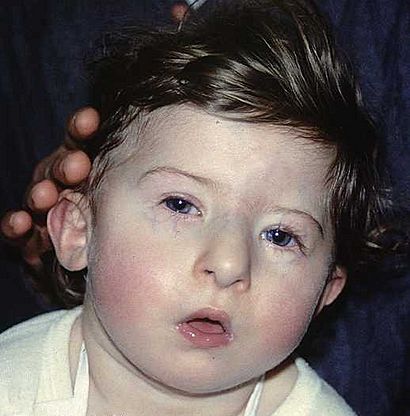DiGeorge syndrome facts for kids
Quick facts for kids DiGeorge syndrome |
|
|---|---|
| Synonyms | DiGeorge anomaly, velocardiofacial syndrome (VCFS), Shprintzen syndrome, conotruncal anomaly face syndrome (CTAF), Takao syndrome, Sedlackova syndrome, Cayler cardiofacial syndrome, CATCH22, 22q11.2 deletion syndrome |
 |
|
| A child with DiGeorge syndrome | |
| Symptoms | Variable; commonly congenital heart problems, specific facial features, cleft palate |
| Complications | Kidney problems, hearing loss, autoimmune disorders |
| Causes | Genetic (typically new mutation) |
| Diagnostic method | Based on symptoms and genetic testing |
| Similar conditions | Smith-Lemli-Opitz syndrome, Alagille syndrome, VACTERL, Oculo-auriculo-vertebral spectrum |
| Treatment | Involves many healthcare specialties |
| Prognosis | Depends on the specific symptoms |
| Frequency | 1 in 4,000 |
DiGeorge syndrome, also known as 22q11.2 deletion syndrome, is a condition caused by a tiny missing piece of chromosome 22. Think of chromosomes as instruction manuals for your body. When a small part of chromosome 22 is missing, it can affect how different parts of the body develop.
The symptoms of DiGeorge syndrome can be different for each person. However, they often include heart problems that are present from birth, special facial features, and a cleft palate (a gap in the roof of the mouth). People with this syndrome might also get infections often, experience delays in development, or have learning challenges. Other issues can include kidney problems, hearing loss, and autoimmune disorders. Autoimmune disorders happen when the body's immune system mistakenly attacks its own healthy cells. Examples include rheumatoid arthritis or Graves disease.
Contents
What Causes DiGeorge Syndrome?
DiGeorge syndrome usually happens when a small section of chromosome 22 is missing. This missing piece contains about 30 to 40 genes. Genes are like tiny blueprints that tell your body how to grow and work.
About 90% of the time, this missing piece is a new mutation. This means it happens by chance during the very early stages of a baby's development. It's not inherited from the parents. However, in about 10% of cases, the condition is inherited from a parent who also has the syndrome. It is an autosomal dominant condition. This means that if you inherit just one affected chromosome 22, you can have the syndrome.
How Is It Diagnosed?
Doctors might suspect DiGeorge syndrome based on a person's symptoms. To confirm the diagnosis, they use genetic testing. This test looks closely at a person's chromosomes to see if the small piece of chromosome 22 is missing.
Treating DiGeorge Syndrome
There is no cure for DiGeorge syndrome, but treatments can help manage the symptoms. Because many different body systems can be affected, treatment often involves a team of different healthcare specialists. For example, a heart doctor might help with heart problems, and a speech therapist might help with speech difficulties related to a cleft palate.
The long-term health of someone with DiGeorge syndrome depends on their specific symptoms. It also depends on how serious their heart and immune system problems are. With proper medical care and support, many people with DiGeorge syndrome can live a normal life.
How Common Is It?
DiGeorge syndrome affects about 1 in every 4,000 people. The syndrome was first described in 1968 by an American doctor named Angelo DiGeorge. Later, in 1981, scientists figured out the genetic cause behind the condition.
| Classification |
[[d:Script error: The function "pageId" does not exist. |D]]
|
|---|---|
| External resources |
|
Images for kids
See also
 In Spanish: Síndrome de DiGeorge para niños
In Spanish: Síndrome de DiGeorge para niños


